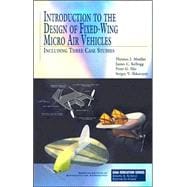
What is included with this book?
| Preface | p. xiii |
| Overview of Micro-Air-Vehicle Development | p. 1 |
| Introduction | p. 1 |
| Historical Perspective | p. 4 |
| Conclusion | p. 34 |
| Acknowledgments | p. 34 |
| References | p. 35 |
| Elements of Aerodynamics, Propulsion, and Design | p. 39 |
| Nomenclature | p. 39 |
| Introduction | p. 41 |
| Rigid Wings | p. 46 |
| Flexible and Adaptive Wings | p. 65 |
| Propulsion | p. 67 |
| MAV Design Using Experimental Database | p. 97 |
| Numerical Approach to MAV Design | p. 99 |
| Conclusion | p. 101 |
| Acknowledgments | p. 102 |
| References | p. 103 |
| Autopilot Integration into Micro Air Vehicles | p. 109 |
| Nomenclature | p. 109 |
| Introduction | p. 110 |
| MAV Designs and Specifications | p. 115 |
| Flight-Control System | p. 118 |
| Stability and Control Design for Micro Air Vehicles | p. 121 |
| Flight Testing | p. 141 |
| Conclusion | p. 146 |
| Appendix | p. 147 |
| Acknowledgments | p. 148 |
| References | p. 148 |
| Case Study: Micro Tactical Expendable Rigid-Wing Micro Air Vehicle | p. 151 |
| Nomenclature | p. 151 |
| Introduction | p. 152 |
| NRL and DARPA MAV Programs | p. 152 |
| Development of the MITE Configuration | p. 153 |
| Detailed Design of the MITE | p. 157 |
| Flight Experimentation and Design Evolution | p. 172 |
| Stability and Flight Control | p. 177 |
| MITE Demonstrations and the Transition to the Dragon Eye UAV | p. 181 |
| Conclusion | p. 181 |
| Acknowledgments | p. 184 |
| References | p. 184 |
| Flexible-Wing Micro Air Vehicles | p. 185 |
| Nomenclature | p. 185 |
| Acronyms | p. 185 |
| Introduction | p. 186 |
| Description of the MAV | p. 190 |
| MAV Fabrication Methods | p. 192 |
| Wind-Tunnel Characterization of the Flexible Wing | p. 199 |
| Modeling of Flexible Wings | p. 225 |
| Flight Testing | p. 236 |
| Conclusion | p. 239 |
| Acknowledgments | p. 239 |
| References | p. 239 |
| Development of Micro Air Vehicles with in-Flight Adaptive Wing | p. 241 |
| Nomenclature | p. 241 |
| Introduction | p. 242 |
| Conceptual Design | p. 245 |
| Wind-Tunnel Testing | p. 251 |
| Design of Adaptive-Wing MAVs | p. 261 |
| Flight Testing | p. 270 |
| Conclusion | p. 273 |
| Acknowledgments | p. 274 |
| References | p. 274 |
| Summary | p. 277 |
| Index | p. 281 |
| Supporting Materials | p. 289 |
| Table of Contents provided by Ingram. All Rights Reserved. |
The New copy of this book will include any supplemental materials advertised. Please check the title of the book to determine if it should include any access cards, study guides, lab manuals, CDs, etc.
The Used, Rental and eBook copies of this book are not guaranteed to include any supplemental materials. Typically, only the book itself is included. This is true even if the title states it includes any access cards, study guides, lab manuals, CDs, etc.